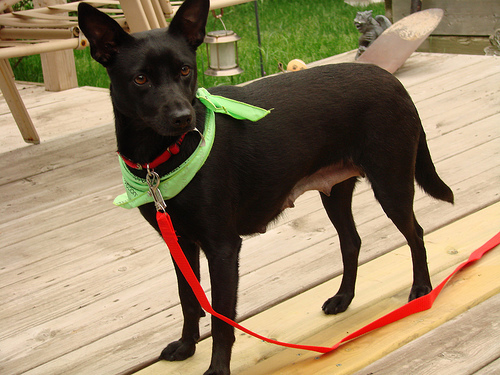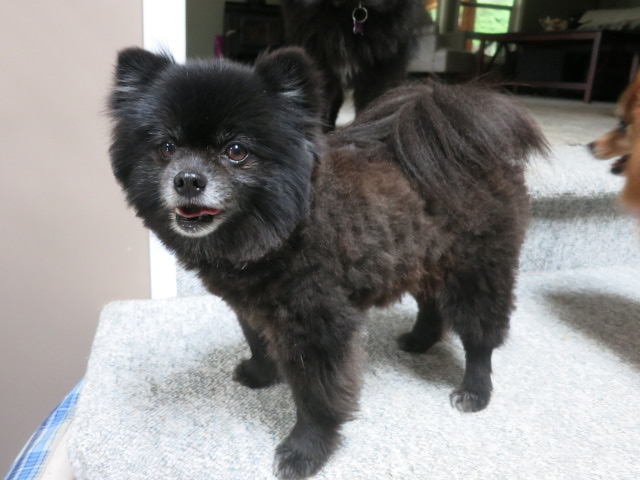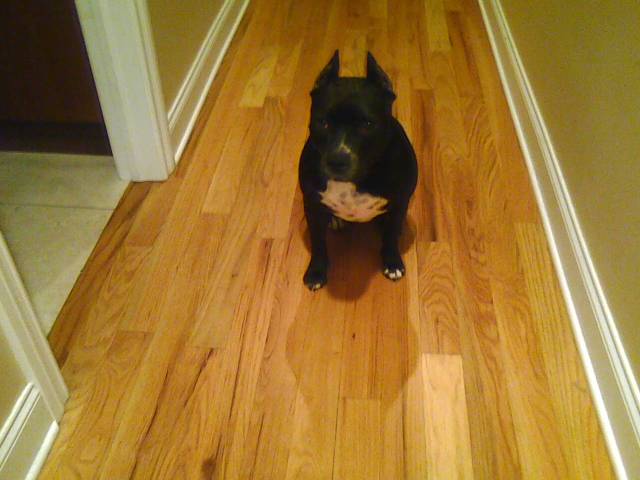QuestionHi, we have adopted a Westie and guess he is about 3-4 years old. Whenever he gets even a little excited, he pees- no matter how many times we take him out, etc. It is not just around one of us, he pees for all of us! Kids are 16,14,and 13, and we have a lab that is about 5? She never does this...just Tuxy- it is getting to the point where we are afraid to even look at him- any advise? Thanks so much for reading and any response would be greatly appreciated- thank you! Laura
AnswerHi Laura,
Thank you for writing to me about your Westie.
Westies are not the only dogs that have problems with submissive peeing. I do believe that your little munchkin may have this condition.
The genetically shy dog is a super submissive type and unlike many dogs are quite sensitive to any forms of "dominant" behavior in humans. Even ordinarily submissive dogs can become extremely submissive if its owner misunderstands and unintentionally forces it to increase its submissiveness. Mistreated dogs may also become excessively submissive.
First, tone down any "dominant" behavior -- with a submissive dog there is no need to consciously dominate it. Examples of dominating behavior include:
Direct eye contact
Standing over the dog
Walking towards the dog while looking at it
Tips:
Wait when you come home. Say "hi" and be verbally friendly, but don't touch or pet it for about 5-15 minutes. Try not to make the moment more exciting than it already is.
When you greet it, get down on its level.
Rather than standing and bending at the waist, bend at the knees (or sit) so that your face is about level with his and you are not looking down on him. This is a less dominant position, and less likely to trigger a submissive posture.
Don't pet it on the head. Rather, tell it to sit, maybe "shake hands", then scratch it under the chin and on the chest. This is less dominating than the pat on the head (because you avoid standing over it).
When you correct this type of dog, do so with your voice only (avoid direct eye contact). If it starts to urinate, then say immediately, "OK, let's go out!" in a happy tone of voice -- and take it out. Or, take a toy out (something it likes to do) and play with it. What you are doing here is telling your dog, "OK, I see your submissiveness. That's good."
When guests come over, ask them to ignore your dog and not look at it even if it comes up and sniffs them. After a bit, when people are sitting down then have them gently put their hands out and talk to your dog, without looking at it. Usually after about 15 minutes or so everything is fine.
In general, show signs of low-key approval immediately when your dog becomes submissive. Then distract it with something else.
When you ignore submissiveness or get mad at it, you're in effect telling the dog "You're not submissive enough!" so the poor thing intensifies its efforts -- and submissive urination is about as submissive as it gets.
Be really positive with your dog, this type lacks self-confidence and will look to you quite often to make sure everything is OK.
One technique that helps many dogs with this problem is called "Flooding." You need a group of people, preferably ones who will stimulate the undesired response (in this case, peeing). You find the least intimidating step for your dog (the point at which your dog does not submissively urinate), one. If your dog urinates, you've gone too fast and you should back up a step until pooch more confident. This process will take a while.
Have your dog sit with you on leash (preferably not on carpeting!)
Have the group of people walk past your dog without looking; when they can do this without your dog peeing, move on to next step (this is true of all steps)
Next have the people look/smile at your dog when they walk past
Next have the people say something to her ("Hi puppy") as they walk past
Next have the people give your dog a treat as they walk past
Next have the people touch your dog (ex. pat on the head) as they walk past
Next, repeat the previous 5 steps but with the people stopping instead of walking past (ie, stop but don't look, stop and look, stop and say hi,...)
If he pees while waiting to go out he is responding to the cues, like putting on your shoes, which are exciting to him. You might want to crate him until you are ready to walk right out the door.
Agility training will help give your dog confidence and has been known to reduce instances of submissive peeing. Additionally, exercise can reduce stress which can lower the incidences of submissive peeing.
As with all physical conditions, be sure that your dog is examined by a vet, including a full blood workup (including a thyroid test).
Best of Luck,
Shelley Davis

 ideas of what breed dog this is?
Question
dog dog
i was wondering if anyone
ideas of what breed dog this is?
Question
dog dog
i was wondering if anyone
 Guessing my dogs mix
Question
matilda
I was wondering if you could help what
Guessing my dogs mix
Question
matilda
I was wondering if you could help what
 Will my Pomeranian loose his hair
Question
My Pomeranian`s hair c
I have a 5 year
Will my Pomeranian loose his hair
Question
My Pomeranian`s hair c
I have a 5 year
 AmStaff Terrier
QuestionMy dog
QUESTION: I have a 2 1/2 year old
AmStaff Terrier
QuestionMy dog
QUESTION: I have a 2 1/2 year old
 Diarrhea in Nursing Bitches
QuestionAtrix & Pup
QUESTION: My Champion Mi
Diarrhea in Nursing Bitches
QuestionAtrix & Pup
QUESTION: My Champion Mi